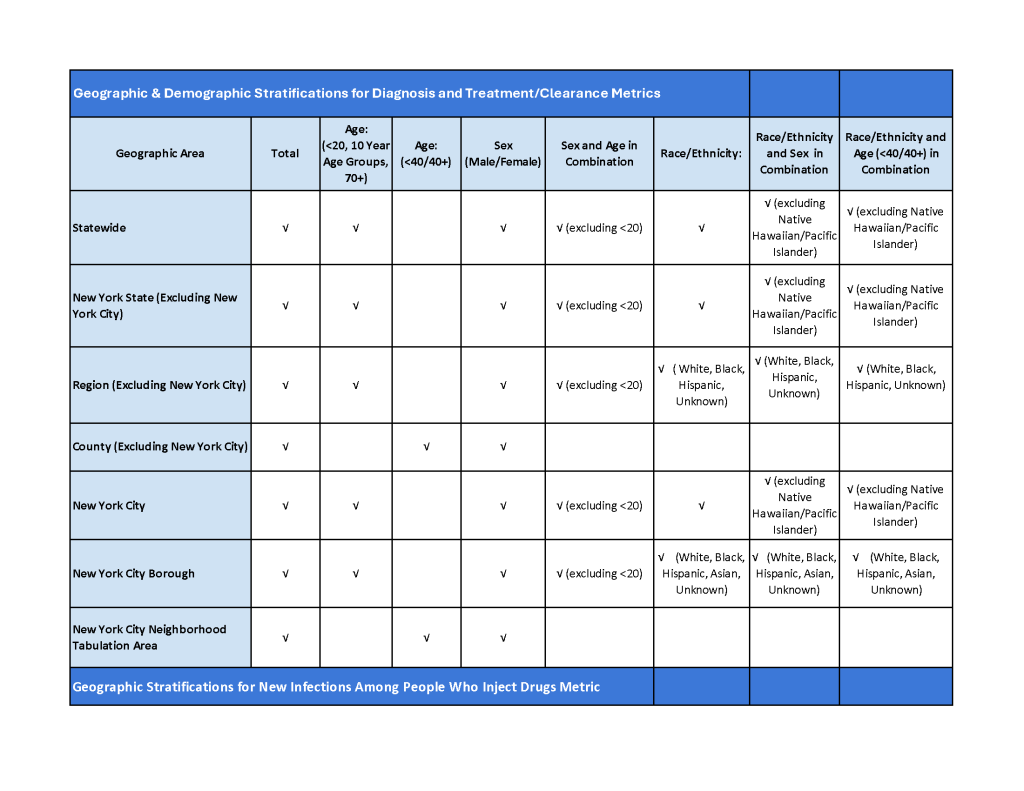HEPATITIS ELIMINATION AND EPIDEMIOLOGY DATASET (HEED)
Both the diagnoses and treatment metrics will utilize HEED, a newly developed statewide dataset designed to support HCV Elimination plan efforts by accounting for individuals with a history of, or current, hepatitis C infection.
Currently, clinical laboratories with New York State (NYS) permits are required by state and local regulations to report positive HCV antibody test results and positive and negative HCV RNA test results to the New York State Department of Health (NYS DOH) through the Electronic Clinical Laboratory Reporting System (ECLRS). For NYS, newly identified HCV acute cases are investigated and data on chronic HCV cases is collected by local health departments. For NYC, in recent years the New York City Department of Health and Mental Hygiene (NYC DOHMH) has conducted enhanced surveillance on a sample of reported cases aged 18-34. In both jurisdictions, demographic information about HCV cases, including race/ethnicity information or selected risk factors, is collected during case investigations. Local health departments across NYS use the NYS Communicable Disease Electronic Surveillance System (CDESS) and NYC DOHMH uses MAVEN, a different electronic surveillance system, to collect and report case surveillance data.
HEED is developed using laboratory data from ECLRS and case surveillance data from CDESS and MAVEN. HEED is updated annually using data from both the NYS DOH and NYC DOHMH to establish the total number of persons living with hepatitis C infection statewide.
Metric Definitions
HCV Diagnoses
The diagnoses metric tracks the number of people newly diagnosed with HCV infection via a positive HCV RNA test (quantitative or qualitative) or genotype test, per year. The diagnosis of HCV infection typically includes an HCV antibody test and an HCV RNA test. However, because antibody tests do not confirm current infection, the diagnoses metric uses positive HCV RNA and genotype tests as its key measure of diagnosis. Learn more about the diagnoses metric methodology.
Data Source: Hepatitis Elimination and Epidemiology Dataset (HEED), using HCV case reporting to the NYS Department of Health (DOH) and the NYC Department of Health and Mental Hygiene (DOHMH).
HCV Treatment/Clearance
The treatment/clearance metric tracks the number of individuals diagnosed with HCV infection who have evidence of treatment for, or clearance of HCV, per year. Individuals with a positive HCV RNA test or genotype followed by a subsequent HCV RNA negative test or treatment indicated by another data source, without any additional positive HCV RNA test or genotype tests, are considered to be treated or cleared of their HCV infection. Negative HCV RNA results became reportable in NYC in 2014 and statewide in 2016, allowing the identification of people who have cleared their infection, either following treatment, or spontaneously without treatment. People who were treated or cleared their infection prior to when negative HCV RNA results were reportable may not be identified as such, resulting in an underestimate of this metric. Additional sources of treatment data will be used to augment this metric in the future. Learn more about the Treatment/Clearance metric methodology.
Data Source: NYS Hepatitis Elimination and Epidemiology Dataset (HEED), augmented by treatment information from other data sources.
New HCV infections among persons who inject drugs
Data Source: NYS Hepatitis Elimination and Epidemiology Dataset (HEED) as of January 2023 and National Center for Health Statistics bridged-race population estimates.
Data Stratifications
The HCV Dashboard displays new HCV diagnoses counts and rates and cumulative percent of HCV treatment/clearance at the statewide and citywide levels, as well as by region, county, borough, and neighborhood tabulation area (NTA).
Data for new HCV infections aged 18-40 is available at the statewide, rest of state (NYS excluding NYC), and NYC citywide levels, with no demographic stratifications currently available.
Demographic Variables
Sex
Sex at birth is defined as male or female, and is obtained from laboratory report. Data on sex are obtained primarily through laboratory reports, which may not reflect the gender identity of the individual. While the NYS DOH is able to capture information on gender, it is incomplete (missing for 95% of records).
Age
Age groups are defined as <20 years; 20-29 years; 30-39 years; 40-49 years; 50-59 years; 60-69 years; and 70+ years at the statewide, region, NYC citywide, and NYC borough levels. At the county level, age groups are defined as <40 years and 40+ years.
Race
Data by race is not currently available and will be included in a future data release. Race and ethnicity are recorded separately.
Ethnicity
Data by ethnicity is not currently available and will be included in a future data release. Race and ethnicity are recorded separately.



